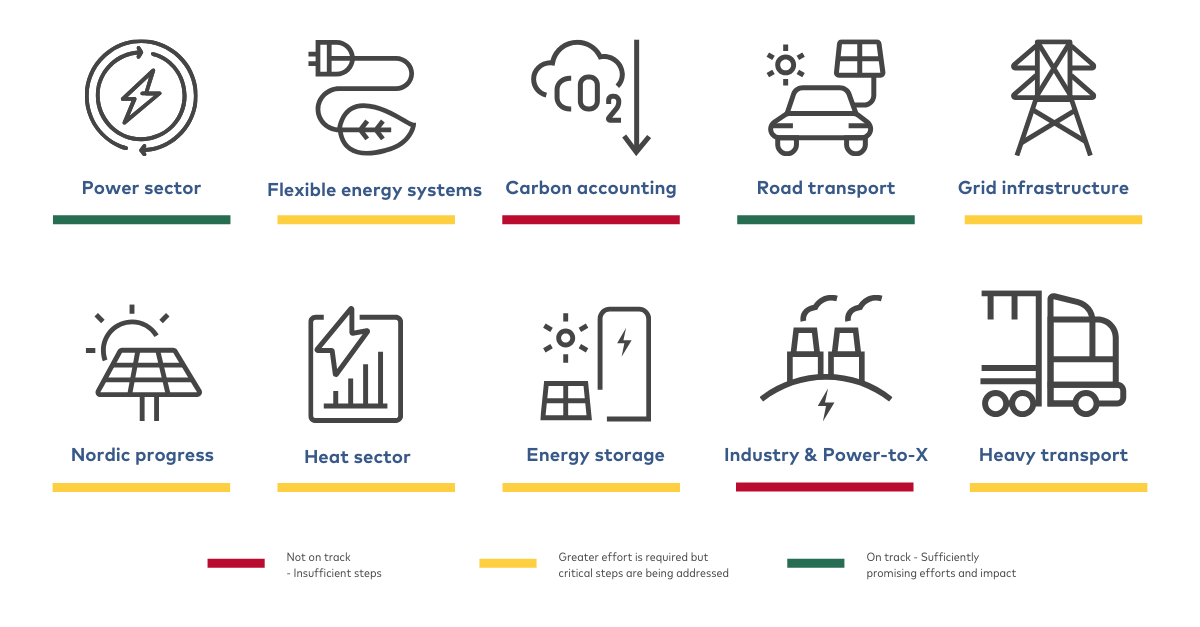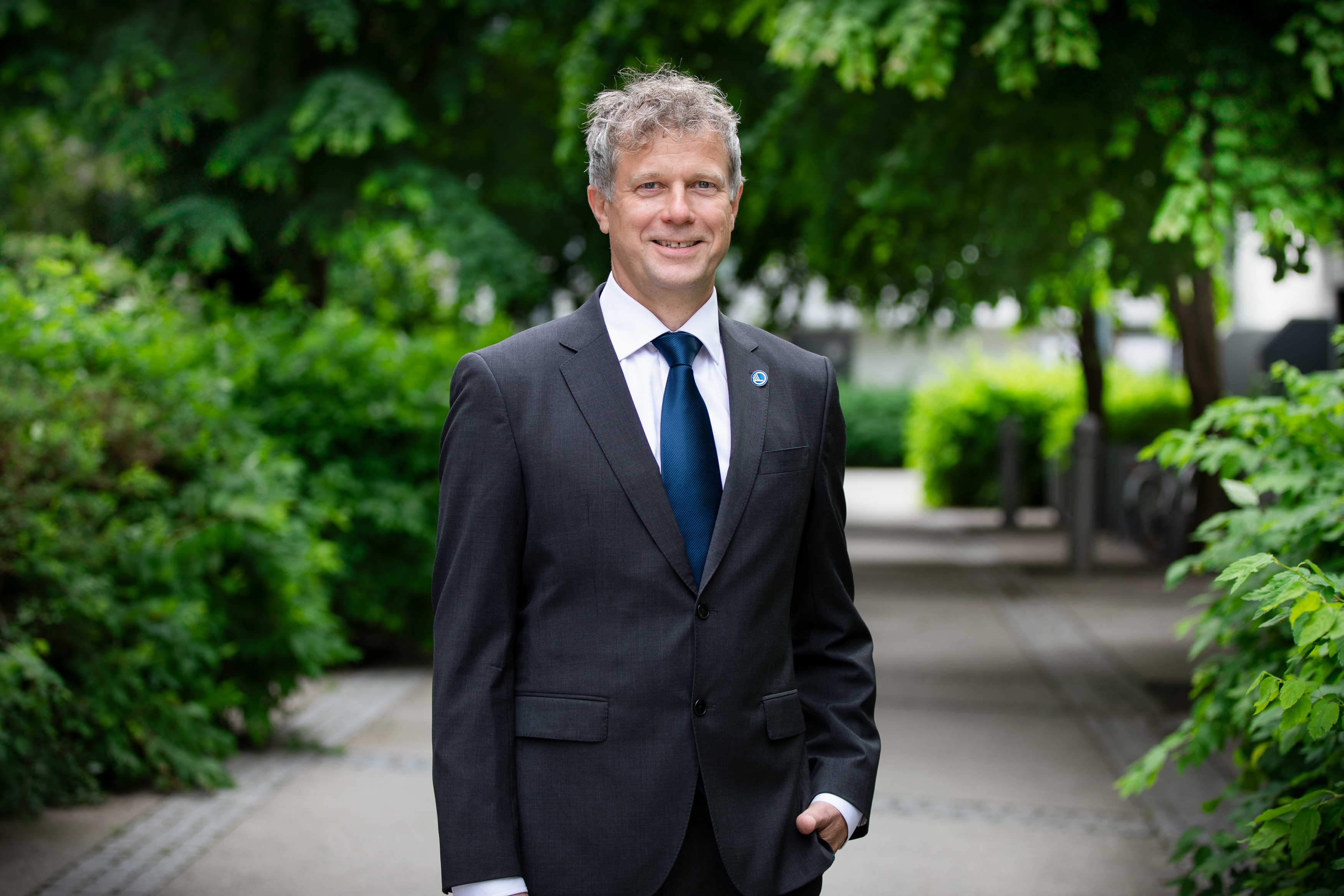New report: Greater effort needed to reach Nordic climate targets in time
The Nordic region's journey to climate neutrality is progressing. However, more effort is needed to reach the goals in time, according to Nordic Energy Research’s new report, Tracking Nordic Clean…
The Nordic region’s journey to climate neutrality is progressing. However, more effort is needed to reach the goals in time, according to Nordic Energy Research’s new report, Tracking Nordic Clean Energy Progress 2025. The report, which compiles the most recent and comprehensive energy data for Denmark, Finland, Iceland, Norway, and Sweden, gives a status update on the countries’ progress towards carbon neutrality.
In 2019, Denmark, Finland, Iceland, Norway, and Sweden signed a joint declaration on Nordic carbon neutrality. To support this commitment, Nordic Energy Research commissioned the Nordic Clean Energy Scenarios study in 2021. The aim of the study was to identify and help prioritise, through scenario modelling, which necessary actions to pursue before 2030 and to map potential long-term pathways to carbon neutrality. Now, four years later, the countries’ progress continues to move forward, but at an insufficient rate.
Status: On track, but the Nordics are at a crossroads

Sectors currently on track are the power sector and road transport. The power sector shows a good pace of decrease in CO₂ despite rising electricity consumption as electricity generation is becoming increasingly renewable. Road transport also shows significant progress with a notable increase in EVs for both cars and vans.
Many sectors show greater need for efforts, and although critical steps are being addressed, the progress is too slow. This includes the heat sector, energy storage, grid infrastructure, flexible energy systems, and heavy transport. In the heat sector, the residential sectors need to shift away from fossil fuels to district heating, electricity, and renewables. The Nordic countries efficiently use large hydro reservoirs for energy storage, but to meet future demands for flexibility, they need significant investments in batteries and hydrogen-based fuels.
For grid infrastructure, there is no aligned strategy for H2/PtX. While electricity exchange has been successful, there are future concerns. The response following the war in Ukraine has shown our resilience in the flexible energy systems, but actions are still needed. Negative power prices highlight the challenges in integrating wind and solar energy. For heavy transport, the picture is mixed. There is promising development in green technology for trucks. However, air travel continues to grow, leading to an increase in emissions from the sector.
One worrying conclusion from the report is that the forest carbon sinks no longer sequester as much carbon as expected, which counters other emission reductions. Also, the industry & power-to-X struggles with its decarbonisation, and the industry needs significant updates to industrial processes and a shift to less carbon-intense solutions. This development is hindered by the cancellation of many big green investments and PtX projects.
A mixed picture calls for more Nordic cooperation

Klaus Skytte, CEO of Nordic Energy Research
“The rate at which CO₂ emissions are decreasing in the Nordics is promising, and notable progress has been made in several sectors. However, there are still many uncertainties that risk altering the Nordic path to carbon neutrality,” says Klaus Skytte, CEO of Nordic Energy Research.
Although the overall rates of CO₂ are decreasing, there are areas that raise special concern.
“Non-CO₂ emissions are lagging, and emissions from LULUCF are moving in the wrong direction. We see that greater efforts will be needed to stay on track, and increased Nordic cooperation is key,” says Skytte.
The Nordic countries progress at a glance
Norway is pioneering some of Europe’s most advanced local flexibility markets. These allow households to help stabilise the electricity grid, and some of the technological solutions are now being exported to, among others, Sweden and the UK. Yet, electricity consumption has surged by 31% since 1990, while road transport emissions decline only gradually despite widespread EV adoption.
Having reduced electricity consumption by 6% since 1990 while at the same time expanding electrification, Sweden is unique. A key driver has been energy efficiency, evident in a 61% spike in heat pump sales from 2021 to 2022. The country is also at the forefront of decarbonising heavy industry, pioneering hydrogen-based steel production. When powered by emission-free electricity, this method significantly cuts CO₂ emissions. Still, the declining capacity of forests to store carbon is concerning, with LULUCF absorption dropping from -56,611 MTCO₂ in 2013 to -41,217 MTCO₂ in 2022.
With fossil fuel and industrial emissions down 42% since 1990, Finland is making strong progress. The country has successfully integrated growing renewable energy sources while maintaining a unified electricity price area. Technological innovation is also advancing, such as the world’s largest cavern heat storage system in Vantaa. However, forests are losing their role as carbon sinks, as LULUCF emissions have turned positive.
Denmark has cut emissions from fossil fuel use and industry by 53% since 1990, demonstrating strong energy efficiency across sectors. A key strategy is the “Climate Alliance,” where municipalities drive local solutions that scale up nationally. That said, transport emissions remain a challenge, with slower EV adoption compared to Nordic neighbours. Additionally, balancing intermittent renewables requires enhanced storage solutions.
Industrial growth and population increase have pushed up Iceland’s energy consumption, though much of the demand is met by expanding geothermal power. The country is a leader in direct air CO₂ capture, a crucial technology for climate goals. Nevertheless, despite rising renewable energy production, total GHG emissions have increased since 1990, underscoring the need for further action.
Recommendations for enhanced Nordic cooperation
Energy security and resilience strategy
- Develop a Nordic energy resilience framework to manage risks from geopolitical tensions, climate change impacts, and supply chain disruptions.
- Coordinate strategic energy reserves and emergency response plans to strengthen energy security across the region.
Coordinated Nordic grid development
- Develop a coordinated Nordic grid plan, leveraging offshore wind synergies.
- Conduct a common Nordic modelling exercise to assess synergies and ensure efficient resource allocation.
Nordic CCS strategy
- Formulate a Nordic carbon capture and storage (CCS) strategy to capitalise on shared infrastructure for carbon transport and storage.
- Enhance collaboration to realise economies of scale and improve overall cost-effectiveness in CCS.
Nordic hydrogen infrastructure roadmap
- Create a joint roadmap for electricity and for clean hydrogen infrastructure, addressing production, transport, and storage needs across the Nordics.
- Focus on harmonising standards to support an integrated hydrogen economy and cross-border trade.
EU regulation alignment
- Establish a coordinated Nordic position on relevant EU regulations to support seamless implementation.
- Work together to align Nordic interests and enhance influence in EU regulatory processes.
Pool resources for innovation
- Secure common funding for pilot projects that demonstrate emerging technologies with the potential to benefit all Nordic countries.
- Focus on identifying and scaling the most promising green technologies for the Nordic region, such as advanced PtX solutions and innovative offshore wind technologies like floating offshore.
About the report
![]()
The Tracking Nordic Clean Energy Progress 2025 tracks the four scenarios developed in the Nordic Clean Energy Scenarios in 2021. By examining country-specific energy data for Denmark, Finland, Iceland, Norway, and Sweden, the report provides the reader with information on what progress has been made in critical sectors such as power, heating, transport, industry, and energy storage. The report provides insights into where progress is being made, where action is still needed, and how these efforts intersect to achieve carbon neutrality.
You can read the whole report here.

